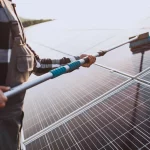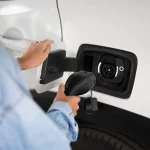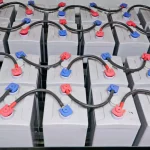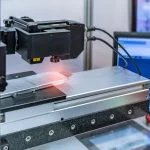Take deep cycle batteries, also known as solar batteries, for instance.
They are designed to provide a steady amount of power over a long period of time. They are also noted for their ability to handle being discharged and recharged multiple times. This type of battery is typically used in renewable energy systems, RVs, boats and even some electrical vehicles.
Over the course of this article, we will take a deep dive into the world of deep cycle batteries and power-up your knowledge. We will look at where they work best, the different types, and how you should maintain your deep cycle batteries.
TL;DR - Quick Takeaways
- Deep cycle batteries provide a stable amount of power over a prolonged period and can be discharged up to 80% of their capacity regularly without losing efficiency.
- Flooded lead acid batteries are cost-effective and reliable but require regular maintenance and proper ventilation due to spill risks.
- AGM batteries are maintenance-free, spill-proof, and suitable for applications like RVs and off-road vehicles.
- Lithium-ion batteries offer high energy density, long lifespan, and low maintenance, making them ideal for advanced applications despite their higher initial cost.
Understanding Deep Cycle Batteries
To understand a deep cycle battery, you have to comprehend its primary function. Although they look similar, deep cycle batteries are not to be confused with car batteries.
A car battery is a starter battery, which provides a short burst of energy – which is ideal for starting an engine. Whereas a deep cycle battery delivers a stable amount of power over a prolonged period. It can also be discharged up to 80% of its capacity on a regular basis without losing its ability to work.
As you can imagine, this is perfect for the likes of RVs and boats, or anything that needs a reliable power source that can be recharged repeatedly.
Types of Deep Cycle Batteries
Now that you’ve gotten to grips with just what exactly a deep cycle battery is, you might be asking yourself ‘what’s the right type for me?’. Below we will go through some of the options available, as well as looking at what makes each one a unique choice, with its own advantages and disadvantages.
There are lead acid batteries, along with lithium-ion batteries. Lead acid batteries include flooded, AGM, and gel types. The battery type you choose will depend on what you plan on using it for.
Lead Acid Batteries
Chances are, if you have heard of deep cycle batteries before, the type you will be familiar with is lead acid batteries. They are the most common type of deep cycle battery, and they are used widely, mainly because they are cost effective and reliable.
Under this banner, you have flooded, AGM, and gel batteries. Each one of these has its characteristics, which we will explore further within this article.
1. Flooded Lead Acid Batteries
The most common type of lead acid batteries are flooded lead acid (also known as wet cell batteries). These batteries have their electrolytes in liquid form. This type of deep cycle battery is renowned for being both cost effective, but also requiring quite a bit of maintenance.
For instance, with this type of battery, you have to regularly check and refill the electrolyte levels. Refusing to do these checks will dramatically reduce the longevity of your battery. Because of this, these batteries are most commonly used where the battery is easily accessed for maintenance.
Pros
- These batteries are generally less expensive than other batteries, such as AGM or lithium-ion batteries.
- They work off a proven and reliable technology that has been used for over a century.
- They are highly recyclable and they are also renowned for being robust.
Cons
- Regular maintenance is required (usually checking electrolytes or adding distilled water).
- They also require ventilation and pose a spill risk due to the liquid involved.
- If not properly maintained, they can have a relatively short lifespan and aren’t as efficient as some other forms of batteries.
2. AGM Batteries
AGM (Absorbent Glass Mat) are a type of deep cycle batteries that use a glass mat to absorb the electrolyte, removing the risk of a spill that exists with the flooded lead-acid batteries.
For the most part, it also makes them maintenance free, which is ideal if you’re using them for solar panels. Thus, you don’t need to check the electrolyte levels. It is also worth noting that AGM batteries can handle deeper discharges, but they do cost more than the aforementioned flooded batteries.
Pros
- AGM batteries don’t require maintenance and there is no risk of spills or leaks.
- They also have a low self-discharge rate and a long lifespan.
- They are vibration and shock resistant and charge quickly, which makes them ideal for the likes of RVs or off-road vehicles.
Cons
- They have a high cost-of-entry price point compared to flooded lead-acid batteries.
- Can be sensitive to being over charged and in regards to high temperatures.
- AGM batteries can also be heavy and bulky.
3. Gel Batteries
The third type of lead acid battery is gel batteries. This is where the electrolyte is suspended in a gel-like substance. Once again, these are leak proof and they also aren’t overly temperamental in extreme temperatures. These types of batteries are ideal for use in extreme environments.
Of course, you should always use the pre-specified charger associated with the battery. If you don’t, it may cause a void in the gel and reduce battery capacity.
Pros
- If you have ever dealt with a battery leak, you will know how advantageous it is to have a leak-proof battery. That’s exactly what gel batteries are.
- They don’t require maintenance.
- Gel batteries perform well in harsh conditions.
Cons
- Require specialist charging equipment.
- Can be quite expensive.
- They have a limited high rate discharge.
Lithium-Ion Batteries
If you are looking for an alternative to lead acid batteries, lithium-ion batteries are a modern option that offer higher energy density, an increased lifespan and are lighter than those traditional options. They are top of the class when it comes to deep cycle batteries – in other words, if you’re looking for a 12v deep cycle battery and budget isn’t an issue, then these are probably your best option.
They are being used more and more often in the likes of electric cars and in renewable energy. With these advantages, there are obviously some downsides; for instance, they are more expensive and may not be your preference if you are a traditionalist. However, when it comes to performance, it is hard to deny their capabilities. The most common type of lithium-ion battery used for deep cycle batteries is Lithium Iron Phosphate (LiFePO4).
Lithium Iron Phosphate batteries are known for their safety, being long-lasting, and their capabilities to deal with different types of conditions. They don’t require much maintenance, but do usually come with a Battery Management System (BMS) so you can stay on top of the battery’s condition. The BMS will usually monitor the health of the battery, as well its charging and discharging state.
Pros
- They have an excellent lifespan and are easier to maintain.
- These batteries also weigh less than many of the alternatives.
- Consistent and strong performance.
Cons
- Initially, you will have to spend more.
- Specific chargers are needed and their management can be complex, with a sophisticated BMS needed.
Key Specifications and Ratings
Now that you understand what a deep cycle battery is and know some of the different types, the next step is to understand some of the ratings used when describing them. These different metrics will help you understand what type of battery is best for you.
They include Amp-Hours (Ah), Depth of Discharge (DoD), and Cycle Life. Essentially, they are ways of detailing a battery’s capacity, how much of it can be used, and how long it will last.
Amp-Hours (Ah)
Amp-Hours (Ah) measures a battery’s ability to give current over a certain amount of time. For example, a 100 Ah battery should be able to provide 1 Amp of current for 100 hours, or alternatively 10 Amps for 10 hours.
This measurement gives a user an idea of when their battery will need its next charge, putting a certain amount of knowledge back in the hands of the owner.
Battery Capacity
| Battery Type |
Capacity (Ah) |
| Deep Cycle Battery 50Ah |
50 |
| Deep Cycle Battery 100Ah |
100 |
| Deep Cycle Battery 150Ah |
150 |
| Deep Cycle Battery 200Ah |
200 |
Deep Cycle Battery Discharge Rates
| Discharge Rate |
Impact on Battery |
| High Rate |
Decreases lifespan, higher power output |
| Moderate Rate |
Balanced lifespan and power output |
| Low Rate |
Increases lifespan, lower power output |
Depth of Discharge (DoD)
In simple terms, DoD is how much of the battery capacity has been used. This is an important metric, as mismanaging the DoD of a battery can damage the overall battery.
For instance, if there is a 50% DoD, 50% of the battery’s capacity has been discharged. It’s worth noting that regularly discharging a battery and recharging it can impact its lifecycle.
Cycle Life
Cycle life is the term used to describe the number of complete discharge-charges a battery can do before its overall lifecycle is diminished. Essentially, a higher life cycle indicates a better quality battery that will last longer.
Certain things can affect the life cycle of a battery, such as how it’s used and maintained. For instance, using the battery beyond its recommended DoD levels could reduce it.
Choosing the Right Deep Cycle Battery
The key factor for picking the right deep cycle battery for you is ‘what will you be using it for?’. Of course, there are other factors, such as what is your budget, is weight an issue, etc.
Below, we’ll look at some of the key points to consider when picking a deep cycle battery.
Application-Specific Selection
It goes without saying, but choosing the right type of battery depends on the application of said battery. Below we look into some of the most common applications for deep cycle batteries and what you should consider when purchasing one for these uses.
RV and Marine Use
For RVs and deep cycle marine batteries applications, AGM batteries are a good option because of their resilience and the lack of maintenance that is required. Travelling in the knowledge that you have a spill-proof battery is reassuring. Lithium-ion batteries also work well, but are more expensive. That being said, it can be worth the investment, because they generally provide a longer lifespan and greater energy density.
Solar Energy Storage with Soly Powercell®
Lithium-ion batteries are a good option for solar energy storage. And with Soly’s solar battery storage solutions, you can achieve up to 80% grid independence. Our range of high quality solar batteries include Enphase, Fox, and GivEnergy. They allow you to store your self-generated electricity efficiently and reduce your reliance on the energy grid while saving on energy costs. This reliability ensures you’re getting good value in the long run for your solar energy system.
Maintenance and Safety of Deep Cycle Batteries
If you want your deep cycle batteries to last, then you have to look after them. Of course, different types have different maintenance requirements, but all deep cycle battery types require some form of care and precaution from the user.
General Maintenance Practices
Staying on top of maintenance can extend your deep cycle battery’s life. There are the obvious steps, like using the right chargers and proper storage. However, there are other things you can do to ensure your batteries stay in the best condition possible.
Charging Guidelines
With any battery, it’s important to follow the manufacturer’s guidelines to keep it in the best condition possible. These guidelines usually involve using a charger that matches the battery type, the right voltage and current.
Both undercharging and overcharging are dangerous and it’s important to understand the dangers of using the wrong charger for a deep cycle battery.
Regular Inspections
Keeping an eye on the condition of your deep cycle batteries will allow you to catch any potential issues before they become a problem. Things you should look for are existing damage, corrosion, and electrolyte levels (for flooded batteries). Taking care of these issues before they worsen can save you time and money in the long-run.
Storage Tips
It should probably go without saying, but keeping your deep cycle battery in the right place will help extend its life. If you are not using them, ensure they are fully charged and store them in a cool dry place.
Safety Precautions
You should always be cautious when dealing with batteries as handling them wrong can lead to issues around your safety. Here are some safety measures you should follow.
Handling Precautions
You should always take precautions while handling deep cycle batteries. Safety glass and protective gloves are essential, especially if moving batteries that have been already subject to spills or leaks.
Ventilation Requirements
It is also important to take ventilation into consideration when dealing with batteries. Flooded lead acid batteries are the most dangerous in this instance, as they can emit hydrogen gas when charging.
Disposal and Recycling
Batteries really shouldn’t end up in landfills. They contain hazardous material so need to be recycled in the correct way. That is why it is important to always recycle your batteries in designated areas. Some retailers also offer battery recycling services, which is ideal for convenient disposal.
Common Questions
We hope our deep-dive has given you some insight into all things deep cycle batteries. However, you may still have a few questions so we will try to solve a couple of the more common queries below.
What is the difference between a deep cycle battery and a starting battery?
Deep cycle batteries are designed to provide a secure level of energy over a long period of time. That is why they are used for things like RVs and solar energy. On the other hand, starting batteries are used for a short burst of energy – mostly to start engines (hence the name!). They are designed to be discharged repeatedly.
How often should I maintain my deep cycle battery?
The answer to the above depends on the type of deep cycle battery you are referring to. For instance, flooded lead batteries require regular maintenance, whereas gel batteries are virtually maintenance-free.
Learnings Recap
Let’s quickly recap some of the key learnings from our deep dive into deep cycle batteries:
- Deep cycle batteries are designed for sustained energy delivery and can be discharged and recharged multiple times.
- There are various types, including Flooded Lead Acid, AGM, Gel, and Lithium-Ion, each with their own pros and cons.
- Key specifications to consider include Amp-Hours (Ah), Depth of Discharge (DoD), and Cycle Life.
- Proper maintenance and safety precautions are crucial for longevity and performance.
- Choosing the right battery depends on the specific application, such as RV, marine, or solar energy storage.
Final Thoughts
At this stage, we hope you have a solid understanding of deep cycle batteries, their uses and how to make sure you are getting the most out of them. Choosing the best battery for your specific needs is not always an easy task, but we hope this guide gives you some insight.
At Soly, we understand the importance of reliable energy solutions. We’ve helped thousands of customers save money by powering their home with solar energy. If you are considering solar power, Soly can save you up to £1,300 per year on your energy bills (allowing you to recoup your investment in just 7-8 years – the industry average is 14!).
Learn more about how you can start saving by contacting our solar experts today!



